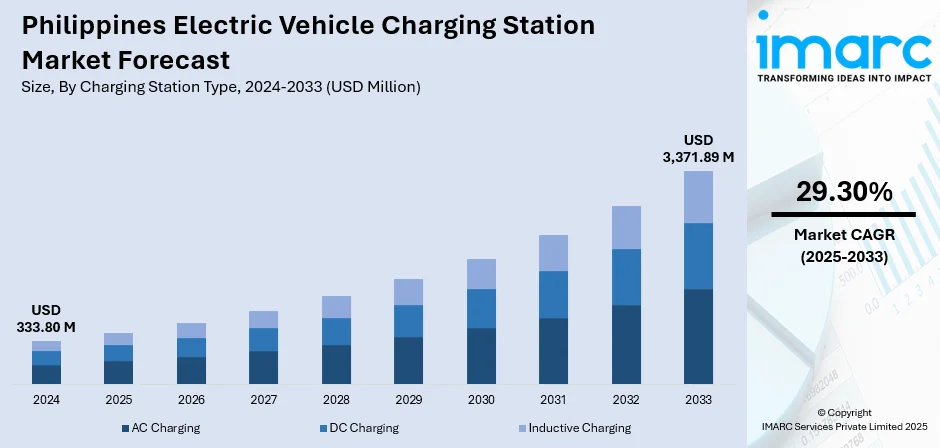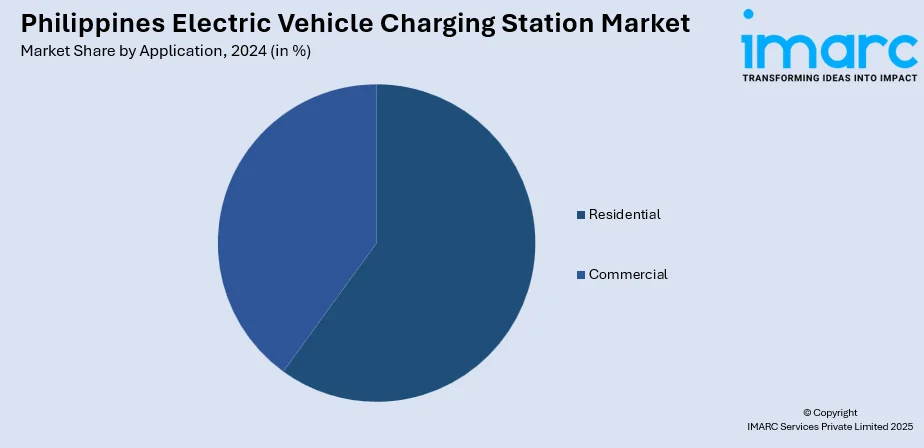
Philippines Electric Vehicle Charging Station Market Size, Share, Trends and Forecast by Charging Station Type, Vehicle Type, Installation Type, Charging Level, Connector Type, Application, and Region, 2025-2033
Philippines Electric Vehicle Charging Station Market Overview:
The Philippines electric vehicle charging station market size reached USD 333.80 Million in 2024. Looking forward, the market is expected to reach USD 3,371.89 Million by 2033, exhibiting a growth rate (CAGR) of 29.30% during 2025-2033. Environmental imperatives, growing EV ownership, and infrastructure investments drive the sector. Public‑private partnerships, renewable energy integration, and mobile app platforms aid expansion. Regional plans and incentives further boost Philippines electric vehicle charging station market share.
|
Report Attribute
|
Key Statistics
|
|---|---|
|
Base Year
|
2024
|
|
Forecast Years
|
2025-2033
|
|
Historical Years
|
2019-2024
|
| Market Size in 2024 | USD 333.80 Million |
| Market Forecast in 2033 | USD 3,371.89 Million |
| Market Growth Rate 2025-2033 | 29.30% |
Philippines Electric Vehicle Charging Station Market Trends:
Government Incentives and Roll‑Out Targets
The Department of Energy’s EV infrastructure roadmap and incentive schemes accelerate Philippines electric vehicle charging station market growth. Announced plans include an ambitious target of deploying over 7,000 public EV charging stations by 2028, up from around 300 in 2023. Partnerships with distribution utilities support integration of solar‑hybrid chargers in provincial hubs. Municipal governments in Cebu and Davao approve rooftop charger installations in transport terminals and public parking. Reduced import tariffs on charging equipment lower capital expenditure. Real‑time station locators and reservation apps improve accessibility. These policy and execution frameworks catalyze station deployment and consumer confidence—driving Philippines electric vehicle charging station market growth.

To get more information on this market, Request Sample
Tech Partnerships and Energy Resiliency
Energy and tech providers collaborate to advance resilient charging solutions, intensifying Philippines electric vehicle charging station market growth. Smart charging networks leverage load‑balancing algorithms and dynamic tariffs to manage grid stress. Pilot microgrid‑linked stations offer backup power during outages in typhoon‑prone regions like Bicol. Blockchain‑based payment systems and interoperable RFID tags enable seamless billing across providers. Integration with digital wallet apps simplifies user experience. Solar‑battery pairing reduces peak demand and lowers operating costs. Maintenance services are bundled with remote diagnostics and OTA updates. These integrated tech and energy resilience solutions strengthen infrastructure reliability and user adoption, reinforcing Philippines electric vehicle charging station market growth. For instance, in March 2025, VinFast expanded its EV ecosystem in the Philippines by partnering with Motech to enhance after-sales services across 63 centers and exploring further regional cooperation. Crucially, VinFast’s charging arm V-GREEN signed an MOU with Taiwan’s eTreego to deploy 100,000 EV charging stations across Southeast Asia, including the Philippines. The move supports rising EV demand and infrastructure development in the region.
Philippines Electric Vehicle Charging Station Market Segmentation:
IMARC Group provides an analysis of the key trends in each segment of the market, along with forecasts at the country and regional levels for 2025-2033. Our report has categorized the market based on charging station type, vehicle type, installation type, charging level, connector type, and application.
Charging Station Type Insights:
- AC Charging
- DC Charging
- Inductive Charging
The report has provided a detailed breakup and analysis of the market based on the charging station type. This includes AC charging, DC charging, and inductive charging.
Vehicle Type Insights:
- Battery Electric Vehicle (BEV)
- Plug-in Hybrid Electric Vehicle (PHEV)
- Hybrid Electric Vehicle (HEV)
The report has provided a detailed breakup and analysis of the market based on the vehicle type. This includes battery electric vehicle (BEV), plug-in hybrid electric vehicle (PHEV), and hybrid electric vehicle (HEV).
Installation Type Insights:
- Portable Charger
- Fixed Charger
A detailed breakup and analysis of the market based on the installation type has also been provided in the report. This includes portable charger and fixed charger.
Charging Level Insights:
- Level 1
- Level 2
- Level 3
A detailed breakup and analysis of the market based on the charging level has also been provided in the report. This includes level 1, level 2, and level 3.
Connector Type Insights:
- Combined Charging Station (CCS)
- CHAdeMO
- Normal Charging
- Tesla Supercharger
- Type-2 (IEC 621196)
- Others
A detailed breakup and analysis of the market based on the connector type has also been provided in the report. This includes combined charging station (CCS), CHAdeMO, normal charging, tesla supercharger, type-2 (IEC 621196), and others.
Application Insights:

- Residential
- Commercial
A detailed breakup and analysis of the market based on the application has also been provided in the report. This includes residential and commercial.
Regional Insights:
- Luzon
- Visayas
- Mindanao
The report has also provided a comprehensive analysis of all the major country markets, which include Luzon, Visayas, and Mindanao.
Competitive Landscape:
The market research report has also provided a comprehensive analysis of the competitive landscape. Competitive analysis such as market structure, key player positioning, top winning strategies, competitive dashboard, and company evaluation quadrant has been covered in the report. Also, detailed profiles of all major companies have been provided.
Philippines Electric Vehicle Charging Station Market News:
- In July 2025, V-Green, Green GSM Philippines, and MERALCO signed an MoU to accelerate EV adoption and charging infrastructure in the Philippines. The partnership aims to deploy public charging stations and electric taxi hubs, especially in Metro Manila. It also explores solar-powered charging, workforce training, and technical collaboration. The initiative supports a full EV mobility ecosystem led by VinFast, combining clean transport, energy, and digital services to drive the country’s transition to sustainable, accessible urban mobility.
- In April 2025, VinFast launched a free EV charging program in the Philippines, available at its V-Green-operated charging stations until May 2027. The initiative was announced alongside the debut of the VF 6 electric SUV at the 2025 Manila Auto Show. VinFast also partnered with EastWest Bank and BDO to offer green financing, supporting broader EV adoption. These efforts aim to build a full EV ecosystem and accelerate the Philippines’ transition to sustainable transportation.
Philippines Electric Vehicle Charging Station Market Report Coverage:
| Report Features | Details |
|---|---|
| Base Year of the Analysis | 2024 |
| Historical Period | 2019-2024 |
| Forecast Period | 2025-2033 |
| Units | Million USD |
| Scope of the Report |
Exploration of Historical Trends and Market Outlook, Industry Catalysts and Challenges, Segment-Wise Historical and Future Market Assessment:
|
| Charging Station Types Covered | AC charging, DC charging, Inductive charging |
| Vehicle Types Covered | Battery electric vehicle (BEV), Plug-in hybrid electric vehicle (PHEV), Hybrid electric vehicle (HEV) |
| Installations Covered | Portable charger, Fixed charger |
| Levels Covered | Level 1, Level 2, Level 3 |
| Connector Types Covered | Combined charging station (CCS), CHAdeMO, Normal charging, Tesla Supercharger, Type-2 (IEC 621196), Others |
| Applications Covered | Residential, Commercial |
| Regions Covered | Luzon, Visayas, Mindanao |
| Customization Scope | 10% Free Customization |
| Post-Sale Analyst Support | 10-12 Weeks |
| Delivery Format | PDF and Excel through Email (We can also provide the editable version of the report in PPT/Word format on special request) |
Key Questions Answered in This Report:
- How has the Philippines electric vehicle charging station market performed so far and how will it perform in the coming years?
- What is the breakup of the Philippines electric vehicle charging station market on the basis of charging station type?
- What is the breakup of the Philippines electric vehicle charging station market on the basis of vehicle type?
- What is the breakup of the Philippines electric vehicle charging station market on the basis of installation type?
- What is the breakup of the Philippines electric vehicle charging station market on the basis of charging level?
- What is the breakup of the Philippines electric vehicle charging station market on the basis of connector type?
- What is the breakup of the Philippines electric vehicle charging station market on the basis of application?
- What is the breakup of the Philippines electric vehicle charging station market on the basis of region?
- What are the various stages in the value chain of the Philippines electric vehicle charging station market?
- What are the key driving factors and challenges in the Philippines electric vehicle charging station market?
- What is the structure of the Philippines electric vehicle charging station market and who are the key players?
- What is the degree of competition in the Philippines electric vehicle charging station market?
Key Benefits for Stakeholders:
- IMARC’s industry report offers a comprehensive quantitative analysis of various market segments, historical and current market trends, market forecasts, and dynamics of the Philippines electric vehicle charging station market from 2019-2033.
- The research report provides the latest information on the market drivers, challenges, and opportunities in the Philippines electric vehicle charging station market.
- Porter's five forces analysis assist stakeholders in assessing the impact of new entrants, competitive rivalry, supplier power, buyer power, and the threat of substitution. It helps stakeholders to analyze the level of competition within the Philippines electric vehicle charging station industry and its attractiveness.
- Competitive landscape allows stakeholders to understand their competitive environment and provides an insight into the current positions of key players in the market.
Need more help?
- Speak to our experienced analysts for insights on the current market scenarios.
- Include additional segments and countries to customize the report as per your requirement.
- Gain an unparalleled competitive advantage in your domain by understanding how to utilize the report and positively impacting your operations and revenue.
- For further assistance, please connect with our analysts.
 Request Customization
Request Customization
 Speak to an Analyst
Speak to an Analyst
 Request Brochure
Request Brochure
 Inquire Before Buying
Inquire Before Buying




.webp)




.webp)












